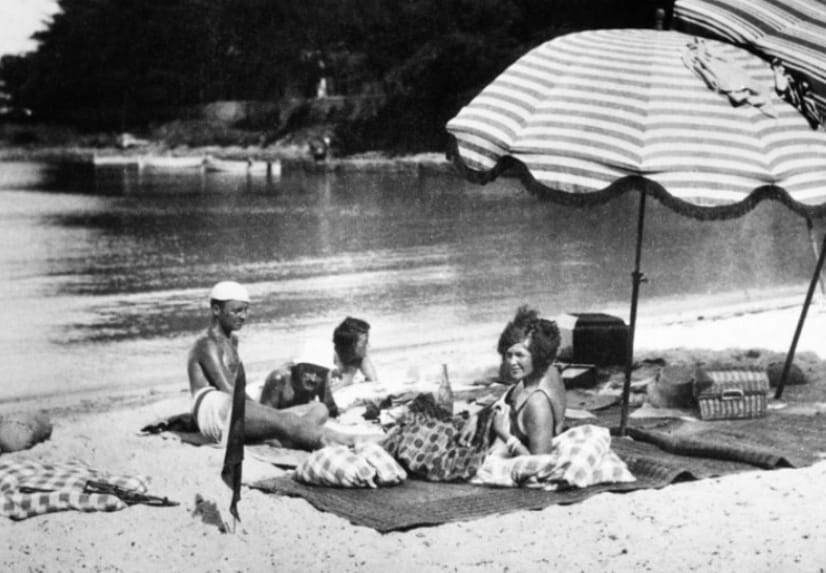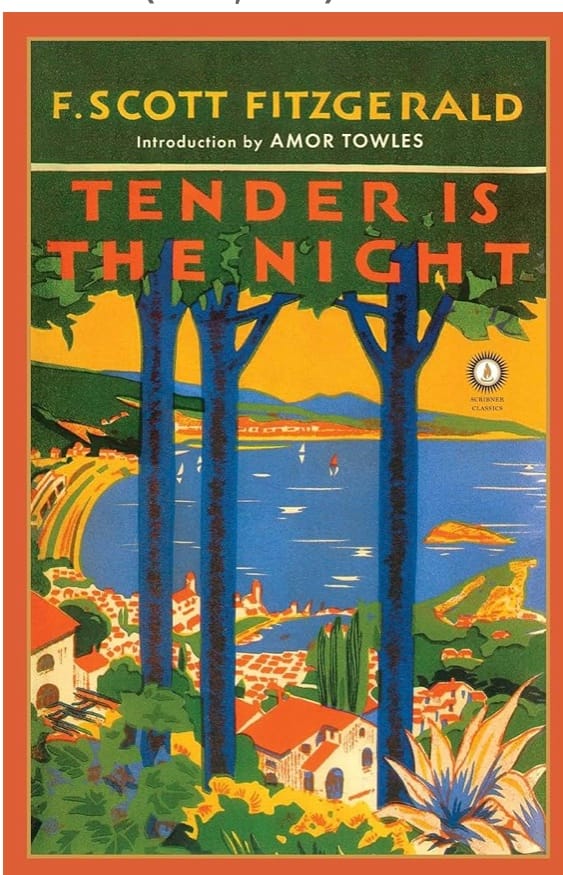The Riviera
“Her bathing suit was pulled off her shoulders and her back, a ruddy, orange brown, set off by a string of creamy pearls, shone in the sun. Her face was hard and lovely and pitiful.” -- F. Scott Fitzgerald

Last week, we met the marvelous Murphys, who ran away from the United States about a century ago, only to find a new and interesting home base in Paris, where they threw intimate parties, and painted Ballet Russes backdrops for free. But one can only stay in the city for so long, and so the Murphys went in search of some Hamptons-esque place where they could unwind in the summer. Cole Porter, who went to Yale with Gerald, told him that the Riviera was the place to be. So he and Sara went to visit Cole and his wife Linda in Antibes, a seaside city located between Cannes and Nice.
"Cole [Porter] always had this great originality about finding new places," Gerald said. "And at that time, no one ever went to the Riviera in summer. The English and the Germans who came down for the short spring season closed their villas as soon as it began to get warm. None of them ever went into the water, you see. When we went to visit Cole, it was hot hot summer, but the air was dry and it was cool in the evening and the water was that wonderful jade and amethyst color."

On the southern part of the cape where Antibes was situated, there was a 40-yard-long beach called La Garoupe, which was covered in four-feet of seaweed. Gerald dug out a corner of the beach and decided that this was where he wanted to be. He and Sara persuaded some hotel owners to keep their place running at minimum capacity so they would have a place to stay during their visits. In summer 1923, the Murphys spent time with the Picassos, who they had come to know from their work with the Ballet Russes. Sara traipsed down to the beach with her long strand of pearls flung around to her back, and Picasso became so enchanted by her that he drew and painted several works with her as the subject. Because Gerald went off to visit Cole in Venice for a bit, some have speculated that Sara and Picasso (who was also married at the time) had a bit of a flirtation at the very least. One scholar found that at least 240 of Picasso's works from 1923 are of Sara, which far outnumbers those he did of his own wife.

Did Gerald suspect anything? It's hard to know. Did anything happen? Again, hard to know. But there was something about that image of Sara's well-tanned back with a milky strand of pearls dripping down it that men found irresistible.

Soon, Scott and Zelda Fitzgerald showed up on the Riviera and befriended the Murphys. They came because they claimed they wanted to live a quieter life. Zelda had fallen in love with a French aviator and Scott didn't know what to do about it, even though the affair had been broken off. Both of them were on edge.
One night, after everyone had gone to bed, Scott woke up Gerald and Sara. He stood outside their door with a candle trembling in his hand. "Zelda's sick," he told them. "I don't think she did it on purpose."
Zelda had swallowed a large quantity of sleeping pills and they spent the evening walking her up and down the and back and forth to keep her awake. This would not be the last time the Murphys would encounter the Fitzergeralds' self-destructive ways. Later that stay, Sara took them to task for coming home late from parties and then diving into the sea from the thirty-foot-high cliffs.
Scott Fitzgerald began sketching Sara into his fiction, and was said to be madly in love with her. He'd do anything to get her attention, whether it was grabbing her and kissing her in taxis (to which she once said "What's a little kiss between friends?"), stuffing dirty franc notes into his mouth and threatening to swallow them (Sara was a world-class germophobe), and sabotaging her dinner parties by asking one too many personal questions. After one such party, when Scott launched several of her precious Venetian glass wine goblets over the garden wall, Sara wrote:
Dear Scott,
I've generally said to you what I've thought. And it seems like this is another of those moments.
We consider ourselves your friends...but you can't expect anyone to like or stand a Continental feeling of analysis and subanalysis and criticism – on the whole unfriendly – such as we have felt for quite a while. It is definitely in the air and quite unpleasant. It certainly detracts from any gathering, and Gerald, for one, simply curls up at the edges and becomes someone else in that sort of atmosphere...You ought to know that at your age you can't have theories about friends. If you can't take your friends largely and without suspicion then they are not friends at all. We cannot, Gerald and I, at our age, and at our stage in life, be bothered with sophomoric situations like last night. We are very simple people...and we are literally and actually fond of you both. And so, for God's sake, take it or leave it as it is meant, a straight gesture, without subtleties.
Your old and rather irritated friend,
Sara
Dramas aside, life seemingly carried on for the Murphys on as it usually did. As locals looked on, there they were on their little slip of beach, hosting elaborate picnics, listening to jazz on their portable phonograph, and swimming in the sea at a time when no one dreamed of going near the water, or bathing in the sun. This was the life, the Murphys agreed, and they decided to buy a villa of their own. After christening it Villa America, they added a second story and a sun roof to the place, and built a marble terrace where they served most of their meals on rattan cafe tables. Guests like Dorothy Parker, Man Ray, and Ballet Russes founder Sergei Diaghilev sipped cocktails that Gerald created with the reverence of a priest preparing for Mass.
Here's one of Gerald's favorite cocktails, The Bailey:
Ingredients:
1-2 sprigs mint torn into pieces
1 1/2 oz gin
1/2 oz grapefruit juice
1/2 oz fresh lime juice
1 tsp simple syrup
sugar for rim of glass (if desired)
Instructions: Tear mint and palce in cocktail shaker. Add gin to shaker and let stand for 1-2 minutes. Add grapefruit juice, lime juice and simple syrup. Shake with ice until cold. Serve in glass rimmed with sugar and with a sprig of mint for garnish.

Ernest Hemingway and his wife Hadley also entered this circle, just as their marriage was coming to an end. The Murphys went with Hemingway to watch bullfights in Pamplona, and then loaned him money and Gerald's studio until he could back on his feet after he and Hadley separated.
Of the separation, Gerald wrote Hemingway: "Hadley and you, I feel, are out after two different kinds of truth in life...Your heart will never be at peace to live, work and enjoy unless you clean up and cut through."
For all the things that were charming about the Murphys, this was not their finest moment. But they believed in his talents and set him up for what would become the most productive period of his career, a period in which he truly began to hone his larger-than-life persona of a hunter-gatherer male with tremendous appetites for drink, global excitement, and beautiful women.
F. Scott Fitzgerald lampooned his friend's growing macho mystique:
"Please write me at length about your adventures," he wrote Hemingway. "I hear you were seen running through Portugal in used BVDs, chewing ground glass, and collecting material for a story about boule players; that you were publicity man for Lindbergh; that you have finished a novel a hundred thousand words long consisting entirely of the word "balls" used in new groupings; that you have been naturalized a Spaniard, dress always in a wine skin with a "zipper" vent and are in engaged in bootlegging Spanish Fly between San Sebastian and Biarritz, where your agents sprinkle it on the floor of the casino. I hope I have been misinformed, but alas it has all too true of a ring..."
For the next decade, the Murphys would call Villa America home. Gerald converted the gardener's cottage on the property into a studio where he worked for several hours a day. Another small building on the property was converted into a guest cottage. The children loved the new place and it seemed by then that the life the Murphys had set out to make for themselves had come together with its intended pattern and rhythm. All around them, people were creating. Edith Wharton wrote The Age of Innocence at a nearby villa. Dancer Isadora Duncan frequented Nice and Cannes. Somerset Maugham bought a villa there just because it seemed like the place to be.
When Gerald finished painting for the day, he emerged from his studio and all the children and grownups would follow him to the beach to unwind. Gerald led the children in calisthenics that included leg lifts, yogic plows, and toe touches. Lunch usually followed all the activity, and after lunch the kids napped. After that break, there were costume parties, children's art shows (judged by Picasso), or excursions to Nice to buy flowers and cheese. Later, the children would have baths and supper, and the adults would dress for dinner in dinner jackets and long, drapey dresses. There was a reason for all this merriment. Villa America was a place where all the terrible things that seemed to be creeping into everyday life could be held at bay, at least for a time. The Murphys never failed to keep things interesting for those in their circle, whether it was ski trips to Austria, boat excursions that ended in treasure hunts for the kids, or any number of perfectly prepared meals, perfectly situated under the light of a Riviera moon.
"I could stand it for about four days," wrote John dos Passos. "It was like trying to live in heaven. I had to get back down to Earth"
Soon, all these expats – the Murphys included – would be forced to return to Earth too, and America, in particular. The exchange rate that had been so favorable to their easy lifestyle had begun to even out. The Great Depression was looming. Some began to feel the pull that came with having an ailing parent too far away. Facing reality, all of these couples recognized that there was no escaping adulthood and responsibility and the ugly side of life forever, no matter how many parties the Murphys threw. It was time to move on and move back home.
Writing prompt: Has there been a time in your life when you realized it was time to move on? What were the circumstances and what steps did you take to move on? Were you successful in doing it?
Coda

As their circle began to dwindle, the Murphys' world came crashing down around them. In 1929, their nine-year-old son Patrick was diagnosed with tuberculosis and sent to a sanatorium in the Swiss Alps, where the family remained nearby for the next year and a half. The Murphys made the most of it, buying a chalet and a bar and inviting their friends to visit.
"The memory of a night with the gay Murphys of Paris and Antibes in that rarified cold silence and atmosphere of death is one of the most terrifying of my life," wrote Donald Ogden Stewart. "But I am prouder of them for that fight for Patrick than I am for anything else in their lives. The point is, they were not only the most alive, most charming, most understanding people – they were – when the roof of their dream house crashed into their living room – the bravest."
Once Patrick was thought to be cured, the family returned to Antibes for two more years. Gerald had given up painting by then and things no longer felt as carefree as they once did. Fascism and Naziism had begun to spread, and Patrick's symptoms returned. They sold their boat, rented out Villa America, and returned to the United States. They would never live in France again.
"I remember saying to [Fitzgerald] that for me, only the invented part of life was satisfying, only that unrealistic part," Gerald said. "Things happened to you...and you couldn't do anything about them...For me, only the invented parts of our lives had any real meaning."
And then tragedy struck. In 1935, their son Baoth died of spinal meningitis, and in 1937, Patrick finally succumbed to tuberculosis.
"In my heart, I dreaded the moment when our youth and invention would be attacked in our only vulnerable spot: the children," Gerald wrote. "How ugly and blasting it can be and how idly ruthless."
What kept Gerald going during this hard and horrible time? Taking the reins of the family business he had fought so hard to avoid. He spent the next 22 years of his life clearing the Mark Cross Company's debts, moving the store to Fifth Avenue and Fifty Second Street, and developing new and tasteful items that could turn a reasonable profit. He wrote that he felt like he was sleepwalking through this time. Together, Sara and Gerald did their best and remained together until the end. Gerald died in October 1964. Sara died in October 1975.
"They were survivors from World War I," their grandson John Donnelly said. "They had come out lost. Between the slaughters and the gassings they had seen their world turned upside down. Did they have an ethos? Something to draw them forward? Well, they had their art, but they were also heavy drinkers and very busy trying to escape."
Tender is the Night

After The Great Gatsby, Scott Fitzgerald struggled to write another book, in part because his alcoholism and Zelda's troubles were making it hard for him to work. He had something in the works, but he turned his focus to short stories and screenwriting because he and Zelda needed the money. Eventually, in 1932, he began writing Tender is the Night, the novel that had been bedeviling him, about a man of almost limitless potential who decides to marry a beautiful, but mentally ill woman, and who ultimately sinks into despair and alcoholism when their marriage fails. The book was dedicated to Gerald and Sara Murphy, and man were they upset about it at first. Dick and Nicole Diver, the two main characters in the book, were a mashup of Scott/Gerald and Zelda/Sara. The Divers get their elegance and warmth from the Murphys, and their ...issues...from the Fitzgeralds. For her part, Sara was livid at how Scott portrayed her in the book. He tried to justify it by saying he was just trying to describe the effect she had on men, himself included. Sara needed time to forgive him, but Gerald was willing to let it go. Though the book did not initially make Scott much money, it is now considered to be one of the top 100 works of literature in the 20th century.
Endnotes
Thank you for tuning in to these stories these past two weeks. I hope you enjoyed them.
Want to read more on Sara and Gerald Murphy? Check out Everybody Was So Young by Amanda Vaill, Sara and Gerald by their daughter Honoria Murphy Donnelly, and Living Well is the Best Revenge by Calvin Tompkins.
Of the three classes I taught at LSU, this one was my favorite. People were really engaged with what was going on, and they surprised me by showing up on the final day of class dressed like they were ready to hang out with the Murphys on the beach. Not gonna lie: I got a little misty.
Hat tip to my beloved graduate school thesis advisor who said I should develop a class on this very subject. He said I would have fun with it and I sure did.
Where I hope you'll donate this week: There is a dynamite young lady named Christine Sylvain who founded Path to College, which cultivates leadership and excellence among overlooked students in the Palm Beach area. Go check out what they do, because it is amazing, and if you can help in any way, please do.
Next week: Back to the present day, for crying out loud. Cooking with Rosa Jackson and some other tidbits that might tickle your fancy.
Paige Bowers Newsletter
Join the newsletter to receive the latest updates in your inbox.




